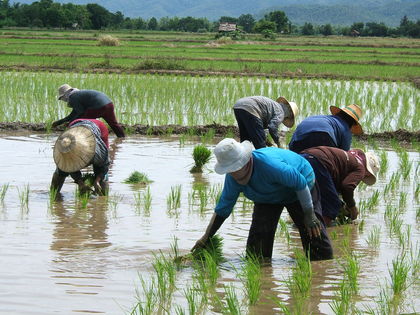Vietnam - Agriculture

Nearly 63% of the labor force of the SRV derives its livelihood from agriculture; arable land in 1998 was 7,202,000 hectares (17,796,000 acres), of which 1,534,000 hectares (3,790,000 acres) were in permanent crops.
Only about 15% of the land in the north is arable, and 14% of it is already under intensive cultivation. Agriculture in the north is concentrated in the lowland areas of the Red River Delta and along the central coast to the south. The Mekong Delta, among the great rice-producing regions of the world, is the dominant agricultural region of the south. Excess grain from the area is shipped to the northern parts of the country. Annual food-grain production averaged 20 million tons in the early 1990s, reaching 33.2 million tons in 1999.
Rice, the main staple of the Vietnamese diet, occupies 94% of arable land. In the north, two and in some cases three crops a year are made possible through an extensive system of irrigation, utilizing upward of 4,000 km (2,500 mi) of dikes. Single-cropping remains the rule in the south, where heavy rains fall for six months of the year and virtually no rain at all during the other six months. The southern region's extensive network of canals is used mainly for transport and drainage, although some irrigational use was attempted under the RVN government. Rice production between 1975 and 1980 was adversely affected by bad weather and the regime's attempt to promote collectivization, but it began to rebound during the early 1980s. In 1980, 11.7 million tons of paddy rice were produced; output rose to 16.2 million tons in 1985 and to 19.2 million tons in 1990. Production totaled 31.4 million tons in 1999.
Other crops include corn, sorghum, cassava, sweet potatoes, beans, fruits, and vegetables. In 1999, estimated production (in thousands of tons) was sugarcane, 17,840; corn, 1,752; groundnuts in shell, 386; and soybeans, 148. Rubber, formerly a major crop and a leading source of foreign exchange, was grown mostly on large plantations organized under the French colonial regime. As a result of the Vietnam war, practically all of the large plantations in the "redlands" area in the south were shut down, and damage to the trees was severe. In 1975, the SRV announced that rubber workers had resumed the extraction of latex from hundreds of thousands of rubber trees on plantations north and northwest of Ho Chi Minh City, most of which had lain fallow for years. Rubber production was given high priority by the Hanoi regime and increased from 40,000 tons in 1975 to an estimated 215,000 tons in 1999. Other industrial and export crops produced in Vietnam include coffee, tea, tobacco, pepper, and jute. In 1999, 487,000 tons of coffee, 62,000 tons of tea, 9,000 tons of jute, 35,000 tons of tobacco, and 70,000 tons of cashews were harvested.
Agriculture in the north has reached an advanced stage of collectivization. A land-reform program completed in 1956 distributed 810,000 hectares (2,002,000 acres) to 2,104,000 peasant families. The share of the Socialist sector in agricultural land increased from 1% in 1955 to 95% in 1975. By 1977, the north had 15,200 agricultural cooperatives and 105 state farms.
In the south, rapid collectivization began in 1978, when the regime announced a program to place the majority of southern farmers in low-level cooperative organizations by the end of the 1976–80 five-year plan. Popular resistance was extensive, however, and by 1981, less than 10% of the rural population was enrolled in full-scale collectives and a roughly equal number in low-level, semi-Socialist production solidarity teams and production collectives.
In an effort to make collectivization more palatable, the regime announced a "household contract" system, permitting members of cooperatives to lease collective land in return for an agreed proportion of total output. This system apparently encouraged many peasants to join cooperative organizations, and the regime announced in mid-1986 that collectivization at the low level had been "basically completed" in the south, with 86.4% of the rural population enrolled in some form of collective organization.
Maybe you can help me get information on someone who can help me import Annatto seeds from Vietnam.
Thank you.
Gee hope one day Vietnam becomes a good country, don't get your hopes up about anything changing in the country though, this is likely to stay this way both with the destruction of it's original flora and fauna and with it's current population.
Mmm soz to leave note in a depressed manner but not much is going to change unless radical change is to occur, which we all know will not happen
I do not think the people in Vietnam intentionally do not care about their environment and only pursue personal/societal gains. I just don't think they are in the position to do so. While both of us are in a position where advanced technology and the green awareness movement and practices is nothing new, I believe that agriculture is a form of sustenance for them.
In time to come, every country will develop with education and infrastructure. This means that Vietnam will be able to move away from being labor-intensive and agricultural based into an industry that is more advanced (maybe manufacturing?). I think they'll better know how to protect their environment then!